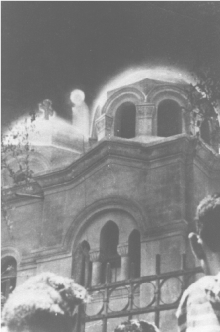Donations: we need and appreciate it!
First there was Myrna Nazzour in Syria [above] — the stigmatic who saw Mary in Damascus, right near where Saul saw the Light, with stiff warnings about the future. Then there was Dina Basher in Iraq — near ancient Nineveh: ditto for stigmatic phenomena and warnings. But now a different one from that same region — in fact, Syria — comes to mind. This is Aleppo — scene of recent horrors in a devastating civil war [bottom] that involves the Syrian government, Russian bombers, and radical Islamists who seek to impose sharia law. It is the most damaged area in the war-torn nation. Since 2012, many have been slain and structures destroyed.

Fascinating it is, how apparitions seem like forerunners of major events — regional apocalypses, if you will. At Medjugorje, apparitions predated a savage civil war also, and the same was true of the Kibeho apparitions in Rwanda, this time one of history’s worst genocides. In Cairo, at Zeitoun, she appeared above a Coptic church called St. Mark’s and recently radicals bombed a church by the same name — St. Mark’s Coptic Orthodox Cathedral — in another part of Cairo. One wonders about the other places where a Mother (like no other mother) warns.
[Return to www.spiritdaily.com]
[February retreat in Vero Beach; details here]
[March retreat in Atlanta]


